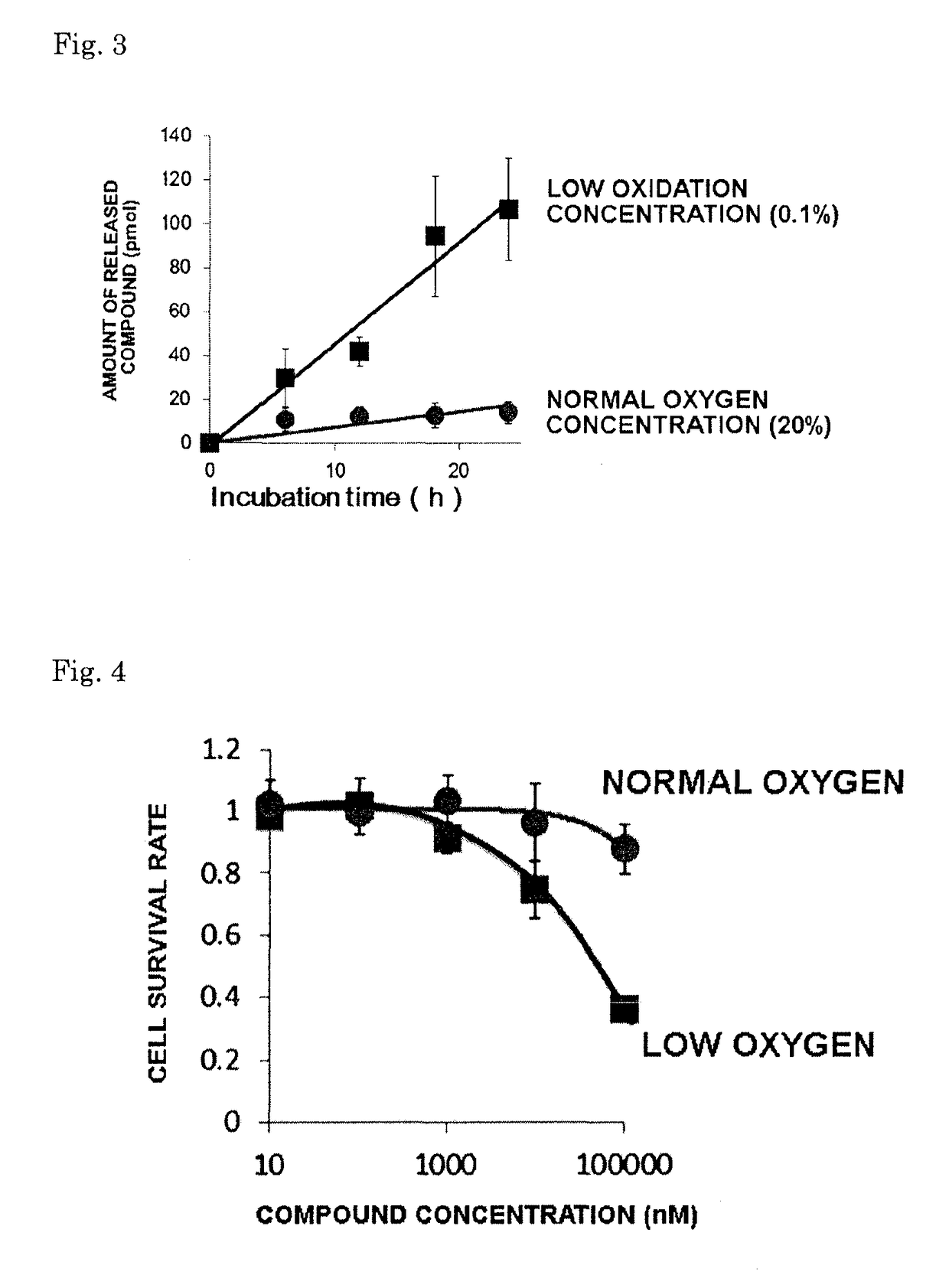Prodrug using nitroimidazole
a technology of nitroimidazole and propionic acid, which is applied in the field of conjugation of 2nitroimidazolepropionic acid and a drug, can solve the problems of no information to indicate that these drugs have been brought to market, and no mention or suggestion whatsoever that such imidazole carboxylic acid has been used, etc., and achieves the effect of facilitating and improving the effect of us
- Summary
- Abstract
- Description
- Claims
- Application Information
AI Technical Summary
Benefits of technology
Problems solved by technology
Method used
Image
Examples
example 1
Reduction of Methyl 3-(2-Nitro-1H-Imidazolyl)propionate
[0055]
[0056]A reaction tube to which had been added 200 mg of Compound 1 synthesized according to a method described in the non-patent document (M. P. Hay et al., J. Med. Chem. 37, 381-391 (1994)) was charged with 10 mL of methanol and 150 mg of Pd / C, then filled with hydrogen gas. With the tube filled with hydrogen gas, stirring was continued for 24 hours. Following the reaction, thin-layer chromatography (TLC) (developing solvent, ethyl acetate:hexane=1:1) was used to confirm that the reaction had proceeded. Next, the Pd / C was removed by Celite filtration and, last of all, the methanol was removed using an evaporator. As a result, a ring structure was rapidly formed in solution during the reducing reaction, without isolation of the Intermediate 3, yielding Compound 4. FIG. 1 shows an NMR chart of the Compound 4 thus obtained.
[0057]It was confirmed from this chart that Compound 4 having a cyclic structure formed due to the redu...
example 2
Preparation of N-Naphthylmethyl-3-(2-Nitro-1H-Imidazolyl)propionylamide
[0058]
[0059]A 50 mL round-bottomed flask was charged with Compound 2 (100 mg) synthesized according to a method described in the non-patent document (M. P. Hay et al., J. Med. Chem. 37, 381-391 (1994)), following which 1-ethyl-3-(3-dimethylaminopropyl)carbodiimide hydrochloride (155.6 mg), N,N-dimethyl-4-aminopyridine (6.7 mg), methylene chloride (5.4 mL) and 1-naphthylmethylamine (119.27 μL) were added to the reactor under stirring with a stirrer and stirring was continued for two days. A 100 mL separatory funnel was charged with 20 mL of ethyl acetate and 20 mL of saturated ammonium chloride, and the organic phase and aqueous phase were separated. A saturated aqueous solution of sodium bicarbonate and a saturated aqueous solution of NaCl were added to the recovered ethyl acetate phase and separation was carried out, thereby recovering the organic phase. The organic phase was dried over anhydrous Na2SO4, followi...
example 3
Reduction of Compound 5
[0061]A stirring bar and Compound 5 (10 mg) were added to a 50 mL round-bottomed flask. While stirring with the stirrer, 10 mL of methanol and 50 mg of Pd / C were added to the reactor, and the reactor was filled with hydrogen gas. With the reactor filled with hydrogen gas, stirring was continued for 24 hours. Following the reaction, TLC (developing solvent, ethyl acetate:hexane=1:1) was used to confirm that the reaction had proceeded. Next, the Pd / C was removed by Celite filtration and, last of all, the methanol was removed using an evaporator. Analysis by electrospray ionization mass spectroscopy (ESI-MS) yielded results indicating the formation of Compound 4. This showed that, together with an intramolecular cyclization reaction, the amide bond cleaved, releasing naphthylmethylamine.
[0062]Compound 4: theoretical molecular weight, 138.067; measured value, 138.063
PUM
| Property | Measurement | Unit |
|---|---|---|
| temperature | aaaaa | aaaaa |
| phosphoric acid | aaaaa | aaaaa |
| concentration | aaaaa | aaaaa |
Abstract
Description
Claims
Application Information
 Login to View More
Login to View More - R&D
- Intellectual Property
- Life Sciences
- Materials
- Tech Scout
- Unparalleled Data Quality
- Higher Quality Content
- 60% Fewer Hallucinations
Browse by: Latest US Patents, China's latest patents, Technical Efficacy Thesaurus, Application Domain, Technology Topic, Popular Technical Reports.
© 2025 PatSnap. All rights reserved.Legal|Privacy policy|Modern Slavery Act Transparency Statement|Sitemap|About US| Contact US: help@patsnap.com



